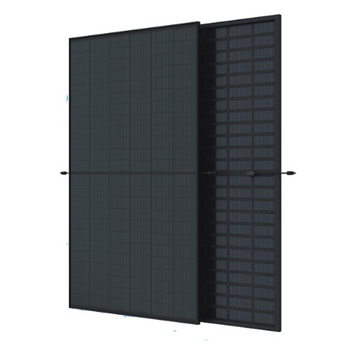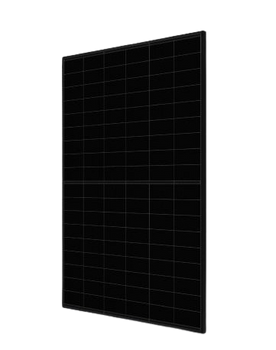Solar Panels
Top Solar Panels for Grid-Tie and Off-Grid Systems
Shop a wide selection of solar panels for both grid-tie and off-grid systems at SolarTown. We offer multiple top brands and provide expert support to help you with sizing and configuration. Find the right solar solution for your DIY project today.
-

Hyundai
$149.99Hyundai, 405W Bifacial PV Module, 1200mm (~47.2”) PV Wire, MC4, 32mm Black Frame/Black Back-Sheet, BOB, 132 1/2 Cell Mono, 20A Max Fuse, 1500VDC, 381.1 PTC, 25/25 Warranty, HiS-S405YH(BK). Features Maximum Test Load Front 5,400Pa Rear...$149.99 -

Trina Solar
$170.99Trina, 425W Bifacial PV Module, PV Wire 1100mm (~43"), MC-4 EVO2 Connector, 30mm Black Frame with Black Back-Sheet, BOB, 144 1/3 Cell, 25A Fuse, 1500VDC, 400.2 PTC, 25/25 Warranty, TSM-425NE09RC.05 Features Small in size, bigger...$170.99 -

ZNshine
Features Excellent Cells EfficiencyMBB technology reduce the distance between busbars and finger grid line which is benefit to power increase. Anti PIDEnsured PID resistance through the quality control of cell manufacturing... -

Trina Solar
Trina, 415W Bifacial PV Module, PV Wire 1100mm (~43”), MC-4 EVO2 Connector, 30mm Black Frame with Black Back-Sheet, BOB, 144 1/3 Cell, 25A Fuse, 1500VDC, 390.5 PTC, 25/25 Warranty, TSM-415NE09RC.05 Features Small in size,... -

Canadian Solar
$168.99Canadian Solar, 450W PV Module, 1800mm (~70.9in) (+) / 1134mm (44.6in) (-) PV Wire, MC-4 or T6, 35mm Black Frame on Black Back-Sheet, BOB, 108 TOPCon Cells, 25A Max Fuse, 1000VDC, No PTC, 25/30 Warranty, CS6.1-54TM-450...$168.99 -


Silfab
Silfab 430w QD mono-PERC module; 108 half cells, black frame, black backsheet, 53.1 in, ø 0.22 in (12 AWG), MC4 from Staubli This product is supplied with MC4 connectors. Features Improved Shade Tolerance Improved Low-Light... -

Canadian Solar
NOTE: This panel is only in stock on the west coast, additional shipping charges will be required for orders in Central or East Coast time zones Canadian Solar, 390W, T4, 35mm Black Frame, Black Backsheet, 132 Cell... -

Aptos
Aptos' DNA Split-cell Series impressively combines advanced technologies to maximize performance. Produce up to 30% more energy with the bi-facial rear side generation. Our patented DNA, Dual Nano Absorber, technology allows for panel to harvest... -

JA Solar
$225.99JA Solar, 550W Bifacial PV Module, MC4-EVO-2, PV Wire, 35mm Clear Frame/White Back-Sheet, BOB, 144 ½ 11BB Bifacial PERCIUM Cells, 25A Max Fuse, 1500Vdc, 516.4 W PTC, 12/30 Warranty, JAM72D30-550/MB. Features: High output power Less...$225.99 -

Hyundai
Hyundai, 410W Bifacial PV Module, 1200mm (~47.2”) PV Wire, MC4, 32mm Black Frame/Black Back-Sheet, BOB, 132 1/2 Cell Mono, 20A Max Fuse, 1500VDC, 386 PTC, 25/25 Warranty, HiS-S410YH(BK). Features Maximum Test Load Front... -

Sonali Solar
Sonali, 420W PV Module, MC4 Compatible, 1200mm (~47") PV Wire, 35mm Black Frame, Black Back Sheet, BOB, 108 N-Type 1/2 Cell, 25A Max Fuse, 1500VDC, 393.2 PTC, 25/30 Warranty, SS-420-108M-B Features Quality Product All Manufactured modules are... -


Silfab
$254.99Silfab 530w XM bifacial module; 132 half cells, silver frame, transparent PV backsheet, 53.1 in, ø 0.22 in (12AWG), EVO2 from StaubliThis product is supplied with MC4 connectors. Features Improved Shade Tolerance Improved Low-Light...$254.99
Solar power modules are devices that convert sunlight into electricity using photovoltaic cells. There are different types of solar power modules available, each with its own characteristics and advantages.
Monocrystalline solar power modules are made from a single, high-purity crystal of silicon, which makes them highly efficient at converting sunlight into electricity. They are also durable and have a long lifespan. Monocrystalline solar panels are usually more expensive than other types of solar panels, but their efficiency can make them a good investment in the long run.
Flexible solar power modules are made from thin, lightweight materials that can be bent or curved to fit a variety of surfaces. This makes them ideal for applications where rigid solar panels are not suitable, such as on boats, RVs, or for portable charging solutions. Flexible solar panels are less efficient than monocrystalline solar panels, but they are more affordable and versatile.
CIGS (copper indium gallium selenide) solar power modules are a newer type of solar panel that are made from thin film cells. They are more efficient than flexible solar panels, but less efficient than monocrystalline solar panels. CIGS solar panels are also more affordable than monocrystalline panels and are easier to manufacture, making them a popular choice for large-scale solar power projects.
All types of solar power modules work by absorbing sunlight and converting it into direct current (DC) electricity. This electricity is then converted into alternating current (AC) using an inverter, which can be used to power electrical devices or sent to the grid for use by others. Solar power modules are a clean, renewable source of energy that can be used to power homes, businesses, and other applications, reducing dependence on non-renewable sources of energy and helping to reduce carbon emissions.
Frequently Asked Questions About Solar Modules
A: A solar module, also known as a solar panel, is an electronic device made up of photovoltaic cells that convert sunlight into electricity.
A: Solar modules convert sunlight into direct current (DC) electricity through the photovoltaic effect. The solar cells in the module absorb photons from the sun's rays and knock electrons off their atoms, creating a flow of electricity.
A: A solar module is typically made up of a series of interconnected photovoltaic cells, a protective backsheet, a front glass cover, a frame, and wiring.
A: The most common types of solar modules are monocrystalline, polycrystalline, and thin-film. Monocrystalline modules are made from a single crystal of silicon and are the most efficient. Polycrystalline modules are made from multiple silicon crystals and are slightly less efficient. Thin-film modules are made from a variety of materials and are the least efficient but also the most flexible.
A: The lifespan of a solar module varies depending on the quality of the module and its maintenance, but most solar modules are designed to last for 25-30 years or more.
A: The performance of a solar module is affected by several factors, including the angle and orientation of the module, the amount of sunlight it receives, the temperature, and any shading that may occur.
A: The amount of electricity a solar module can produce depends on its size and efficiency, as well as the amount of sunlight it receives. A typical residential solar module can produce between 250 and 400 watts of electricity during peak solar hours.
A: Solar modules can be used in a wide range of weather conditions, including cloudy days. However, their performance may be affected by extreme temperatures, heavy rain or snow, and high winds.
A: Many countries offer incentives for installing solar modules, such as tax credits, rebates, and net metering programs that allow homeowners to sell excess energy back to the grid.
